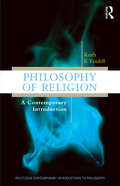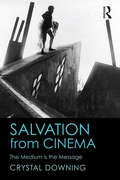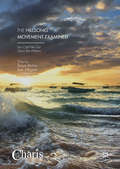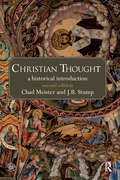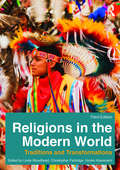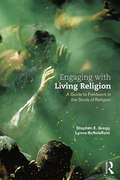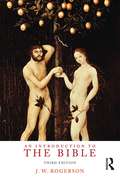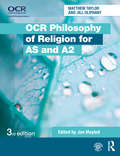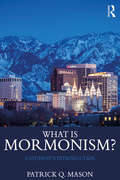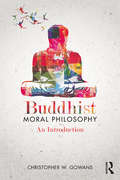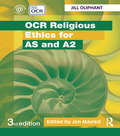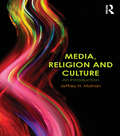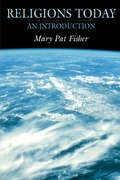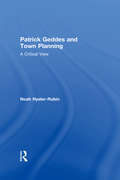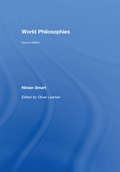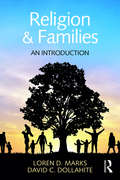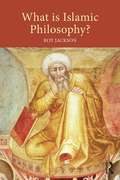- Table View
- List View
Philosophy of Religion: A Contemporary Introduction (Routledge Contemporary Introductions to Philosophy)
by Keith E. YandellKeith Yandell's Philosophy of Religion: A Contemporary Introduction was one of the first textbooks to explore the philosophy of religion with reference to religions other than Christianity.?This new, revised edition explores the logical validity and truth claims of several world religions—Christianity, Judaism, Islam, Hinduism, Buddhism, and Jainism—with updated, streamlined discussions on important topics in philosophy of religion such as: Religious pluralism Freedom and responsibility Evidentialist Moral Theism Reformed Epistemology Doxastic Practice Epistemology The problem of evil Ontological and cosmological arguments Other new features include updated Questions for Reflection,and new Annotated Bibliographies for each chapter, as well as an updated Glossary. This exciting new edition, much like its classic predecessor, is sure to be a classroom staple for undergraduate students studying philosophy of religion, as well as a comprehensive introductory read for anyone interested in the subject.
Salvation from Cinema: The Medium is the Message
by Crystal DowningSalvation from Cinema offers something new to the burgeoning field of "religion and film": the religious significance of film technique. Discussing the history of both cinematic devices and film theory, Crystal Downing argues that attention to the material medium echoes Christian doctrine about the materiality of Christ’s body as the medium of salvation. Downing cites Jewish, Muslim, Buddhist, and Hindu perspectives on film in order to compare and clarify the significance of medium within the frameworks of multiple traditions. This book will be useful to professors and students interested in the relationship between religion and film.
The Hillsong Movement Examined: You Call Me Out Upon the Waters
by Tanya Riches Tom WagnerThis interdisciplinary volume brings together leading writers and thinkers to provide a critique of a broad range of topics related to Hillsong Church. Hillsong is one of the most influential, visible, and (in some circles) controversial religious organizations/movements of the past thirty years. Although it has received significant attention from both the academy and the popular press, the vast majority of the scholarship lacks the scope and nuance necessary to understand the complexity of the movement, or its implications for the social, cultural, political, spiritual, and religious milieus it inhabits. This volume begins to redress this by filling important gaps in knowledge as well as introducing different audiences to new perspectives. In doing so, it enriches our understanding of one of the most influential Christian organizations of the late 20th and early 21st centuries.
The Hillsong Movement Examined: You Call Me Out Upon the Waters
by Tanya Riches Tom WagnerThis interdisciplinary volume brings together leading writers and thinkers to provide a critique of a broad range of topics related to Hillsong Church. Hillsong is one of the most influential, visible, and (in some circles) controversial religious organizations/movements of the past thirty years. Although it has received significant attention from both the academy and the popular press, the vast majority of the scholarship lacks the scope and nuance necessary to understand the complexity of the movement, or its implications for the social, cultural, political, spiritual, and religious milieus it inhabits. This volume begins to redress this by filling important gaps in knowledge as well as introducing different audiences to new perspectives. In doing so, it enriches our understanding of one of the most influential Christian organizations of the late 20th and early 21st centuries.
Christian Thought: A Historical Introduction
by Chad Meister James StumpThe story of Christian thought is essential to understanding Christian faith today and the last two millennia of world history. This fresh and lively introduction explores the central ideas, persons, events, and movements that gave rise to Christian thought, from early beginnings to its present forms. By highlighting the important but often neglected role of women and the influence of non-Christian ideas and movements, this book provides a broader context for understanding the history of Christian ideas and their role in shaping our world. Christian Thought: provides an overview of the context of Christianity’s origin, including discussion of the influence of Hebrews, Greeks, and Romans explores the major events and figures of the history of Christian thought, while drawing attention to significant voices which have often been suppressed analyses the impact on Christian thought of widely discussed events such as The Great Schism, the Scientific Revolution, and modernism surveys contemporary trends such as fundamentalism, feminism, and postmodernism. This fully revised and updated second edition features a new chapter on liberal theology and reflects recent scholarship in the field. Complete with figures, timelines and maps, this is an ideal resource for anyone wanting to learn more about the development of Christian thought and its influence over the centuries. Further teaching and learning resources are available on the companion website at www.routledge.com/cw/meister.
Religions in the Modern World: Traditions and Transformations
by Linda Woodhead Christopher Partridge Hiroko KawanamiReligions in the Modern World: Traditions and Transformations, Third Edition is the ideal textbook for those coming to the study of religion for the first time, as well as for those who wish to keep up-to-date with the latest perspectives in the field. This third edition contains new and upgraded pedagogic features, including chapter summaries, key terms and definitions, and questions for reflection and discussion. The first part of the book considers the history and modern practices of the main religious traditions of the world, while the second analyzes trends from secularization to the rise of new spiritualities. Comprehensive and fully international in coverage, it is accessibly written by practicing and specialist teachers.
Engaging with Living Religion: A Guide to Fieldwork in the Study of Religion
by Stephen E. Gregg Lynne ScholefieldUnderstanding living religion requires students to experience everyday religious practice in diverse environments and communities. This guide provides the ideal introduction to fieldwork and the study of religion outside the lecture theatre. Covering theoretical and practical dimensions of research, the book helps students learn to ‘read’ religious sites and communities, and to develop their understanding of planning, interaction, observation, participation and interviews. Students are encouraged to explore their own expectations and sensitivities, and to develop a good understanding of ethical issues, group-learning and individual research. The chapters contain student testimonies, examples of student work and student-led questions.
An Introduction to the Bible
by J. W. RogersonA casual reader enters a bookshop looking for a Bible. However, not all the Bibles on display have the same contents! Some have more books than others, some are study editions, some use gender-free language. How did this come about? This Introduction works back through the processes by which the Bible was written, transmitted, copied and declared to be authoritative by various churches. The following topics are dealt with: What is the Bible?; How Biblical Writers Wrote; The Making of the Old Testament; The Making of the Apocrypha; The Making of the New Testament; The Canon of the Bible; The Study of the Bible; The Use of the Bible in Social, Moral and Political Questions. This updated edition takes account of developments in scholarship since the book was first published in 1999 by Penguin. The original edition has been translated into Spanish and Portuguese.
An Introduction to the Bible
by J. W. RogersonA casual reader enters a bookshop looking for a Bible. However, not all the Bibles on display have the same contents! Some have more books than others, some are study editions, some use gender-free language. How did this come about? This Introduction works back through the processes by which the Bible was written, transmitted, copied and declared to be authoritative by various churches. The following topics are dealt with: What is the Bible?; How Biblical Writers Wrote; The Making of the Old Testament; The Making of the Apocrypha; The Making of the New Testament; The Canon of the Bible; The Study of the Bible; The Use of the Bible in Social, Moral and Political Questions. This updated edition takes account of developments in scholarship since the book was first published in 1999 by Penguin. The original edition has been translated into Spanish and Portuguese.
OCR Philosophy of Religion for AS and A2
by Jill Oliphant Jon Mayled Matthew TaylorStructured directly around the specification of the OCR, this is the definitive textbook for students of Advanced Subsidiary or Advanced Level courses. The updated third edition covers all the necessary topics for Philosophy of Religion in an enjoyable student-friendly fashion. Each chapter includes: a list of key issues OCR specification checklist explanations of key terminology overviews of key scholars and theories self-test review and exam practice questions. To maximise students’ chances of success, the book contains a section dedicated to answering examination questions. It comes complete with diagrams and tables, lively illustrations, a comprehensive glossary and full bibliography. Additional resources are available via the companion website at www.routledge.com/cw/mayled.
What is Mormonism?: A Student's Introduction (What is this thing called Religion?)
by Patrick Q. MasonWhat is Mormonism? A Student’s Introduction is an easy-to-read and informative overview of the religion founded by Joseph Smith in 1830. This short and lively book covers Mormonism’s history, core beliefs, rituals, and devotional practices, as well as the impact on the daily lives of its followers. The book focuses on the Church of Jesus Christ of Latter-day Saints, the Salt Lake City-based church that is the largest and best-known expression of Mormonism, whilst also exploring lesser known churches that claim descent from Smith’s original revelations. Designed for undergraduate religious studies and history students, What is Mormonism? provides a reliable and easily digestible introduction to a steadily growing religion that continues to befuddle even learned observers of American religion and culture.
Buddhist Moral Philosophy: An Introduction
by Christopher W. GowansThe first book of its kind, Buddhist Moral Philosophy: An Introduction introduces the reader to contemporary philosophical interpretations and analyses of Buddhist ethics. It begins with a survey of traditional Buddhist ethical thought and practice, mainly in the Pali Canon and early Mah?y?na schools, and an account of the emergence of Buddhist moral philosophy as a distinct discipline in the modern world. It then examines recent debates about karma, rebirth and nirvana, well-being, normative ethics, moral objectivity, moral psychology, and the issue of freedom, responsibility and determinism. The book also introduces the reader to philosophical discussions of topics in socially engaged Buddhism such as human rights, war and peace, and environmental ethics.
Buddhist Moral Philosophy: An Introduction
by Christopher W. GowansThe first book of its kind, Buddhist Moral Philosophy: An Introduction introduces the reader to contemporary philosophical interpretations and analyses of Buddhist ethics. It begins with a survey of traditional Buddhist ethical thought and practice, mainly in the Pali Canon and early Mah?y?na schools, and an account of the emergence of Buddhist moral philosophy as a distinct discipline in the modern world. It then examines recent debates about karma, rebirth and nirvana, well-being, normative ethics, moral objectivity, moral psychology, and the issue of freedom, responsibility and determinism. The book also introduces the reader to philosophical discussions of topics in socially engaged Buddhism such as human rights, war and peace, and environmental ethics.
OCR Religious Ethics for AS and A2
by Jill Oliphant Jon MayledStructured directly around the specification of the OCR, this is the definitive textbook for students of Advanced Subsidiary or Advanced Level courses. The updated third edition covers all the necessary topics for Religious Ethics in an enjoyable student-friendly fashion. Each chapter includes: a list of key issues OCR specification checklist explanations of key terminology overviews of key scholars and theories self-test review questions exam practice questions. To maximise students' chances of success, the book contains a section dedicated to answering examination questions. It comes complete with diagrams and tables, lively illustrations, a comprehensive glossary and full bibliography. Additional resources are available via the companion website.
OCR Religious Ethics for AS and A2
by Jill Oliphant Jon MayledStructured directly around the specification of the OCR, this is the definitive textbook for students of Advanced Subsidiary or Advanced Level courses. The updated third edition covers all the necessary topics for Religious Ethics in an enjoyable student-friendly fashion. Each chapter includes: a list of key issues OCR specification checklist explanations of key terminology overviews of key scholars and theories self-test review questions exam practice questions. To maximise students' chances of success, the book contains a section dedicated to answering examination questions. It comes complete with diagrams and tables, lively illustrations, a comprehensive glossary and full bibliography. Additional resources are available via the companion website.
Media, Religion and Culture: An Introduction
by Jeffrey H. MahanReligion has always been shaped by the media of its time, and today we live in a media culture that informs much of what we think and how we behave. Religious believers, communities and institutions use media as tools to communicate, but also as locations where they construct and express identity, practice religion, and build community. This lively book offers a comprehensive introduction to the contemporary field of religion, media, and culture. It explores: the religious content of media texts and the reception of those texts by religious consumers who appropriate and reuse them in their own religious work; how new forms of media provide fresh locations within which new religious voices emerge, people reimagine the "task" of religion, and develop and perform religious identity. Jeffrey H. Mahan includes case study examples from both established and new religions and each chapter is followed by insightful reflections from leading scholars in the field. Illustrated throughout, the book also contains a glossary of key terms, discussion questions, and suggestions for further reading.
Media, Religion and Culture: An Introduction
by Jeffrey H. MahanReligion has always been shaped by the media of its time, and today we live in a media culture that informs much of what we think and how we behave. Religious believers, communities and institutions use media as tools to communicate, but also as locations where they construct and express identity, practice religion, and build community. This lively book offers a comprehensive introduction to the contemporary field of religion, media, and culture. It explores: the religious content of media texts and the reception of those texts by religious consumers who appropriate and reuse them in their own religious work; how new forms of media provide fresh locations within which new religious voices emerge, people reimagine the "task" of religion, and develop and perform religious identity. Jeffrey H. Mahan includes case study examples from both established and new religions and each chapter is followed by insightful reflections from leading scholars in the field. Illustrated throughout, the book also contains a glossary of key terms, discussion questions, and suggestions for further reading.
Religions Today: An Introduction
by Mary Pat FisherReligions Today provides a sympathetic account of what living religions really are. Fisher traces the historical development and practices of major religious movements and explores how these evolve into contemporary belief and teaching. She considers major faiths as well as indigenous religions and new religious movements, focusing on how living religions affect contemporary society. Case studies and interviews with living people ensure that this concise guide is both readable and stimulating.
Religions Today: An Introduction
by Mary Pat FisherReligions Today provides a sympathetic account of what living religions really are. Fisher traces the historical development and practices of major religious movements and explores how these evolve into contemporary belief and teaching. She considers major faiths as well as indigenous religions and new religious movements, focusing on how living religions affect contemporary society. Case studies and interviews with living people ensure that this concise guide is both readable and stimulating.
Patrick Geddes and Town Planning: A Critical View
by Noah Hysler-RubinPatrick Geddes is considered a forefather of the modern urban planning movement. This book studies the various, and even opposing ways, in which Geddes has been interpreted up to this day, providing a new reading of his life, writing and plans. Geddes' scrutiny is presented as a case study for Town Planning as a whole. Tying together for the first time key concepts in cultural geography and colonial urbanism, the book proposes a more vigorous historiography, exposing hidden narratives and past agendas still dominating the disciplinary discourse. Written by a cultural geographer and a town planner, this book offers a rounded, full-length analysis of Geddes' vision and its material manifestation, functioning also as a much needed critical tool to evaluate Modern Town Planning as an academic and practical discipline. The book also includes a long overdue model of his urban theory.
Patrick Geddes and Town Planning: A Critical View
by Noah Hysler-RubinPatrick Geddes is considered a forefather of the modern urban planning movement. This book studies the various, and even opposing ways, in which Geddes has been interpreted up to this day, providing a new reading of his life, writing and plans. Geddes' scrutiny is presented as a case study for Town Planning as a whole. Tying together for the first time key concepts in cultural geography and colonial urbanism, the book proposes a more vigorous historiography, exposing hidden narratives and past agendas still dominating the disciplinary discourse. Written by a cultural geographer and a town planner, this book offers a rounded, full-length analysis of Geddes' vision and its material manifestation, functioning also as a much needed critical tool to evaluate Modern Town Planning as an academic and practical discipline. The book also includes a long overdue model of his urban theory.
World Philosophies
by Ninian Smart Oliver LeamanWorld Philosophies presents in one volume a superb introduction to all the world’s major philosophical and religious traditions. Covering all corners of the globe, Ninian Smart’s work offers a comprehensive and global philosophical and religious picture. In this revised and expanded second edition, a team of distinguished scholars, assembled by the editor Oliver Leaman, have brought Ninian Smart’s masterpiece up to date for the twenty-first century. Chapters have been revised by experts in the field to include recent philosophical developments, and the book includes a new bibliographic guide to resources in world philosophies. A brand new introduction which celebrates the career and writings of Ninian Smart, and his contribution to the study of world religions, helps set the work in context.
World Philosophies
by Ninian Smart Oliver LeamanWorld Philosophies presents in one volume a superb introduction to all the world’s major philosophical and religious traditions. Covering all corners of the globe, Ninian Smart’s work offers a comprehensive and global philosophical and religious picture. In this revised and expanded second edition, a team of distinguished scholars, assembled by the editor Oliver Leaman, have brought Ninian Smart’s masterpiece up to date for the twenty-first century. Chapters have been revised by experts in the field to include recent philosophical developments, and the book includes a new bibliographic guide to resources in world philosophies. A brand new introduction which celebrates the career and writings of Ninian Smart, and his contribution to the study of world religions, helps set the work in context.
Religion and Families: An Introduction (Textbooks in Family Studies)
by Loren D. Marks David C. DollahiteThis is the first multidisciplinary text to address the growing scholarly connection between religion and family life. The latest literature from family studies, psychology, sociology, and religion is reviewed along with narratives drawn from interviews with 200 racially, religiously, and regionally diverse families which bring the concepts to life. Written in a thought-provoking, accessible, and sometimes humorous style by two of the leading researchers in the field, the book reflects the authors’ firsthand experience in teaching today’s students about religion’s impact on families. Prior to writing the book, the authors read the sacred texts of many faiths, interviewed religious leaders, and attended religious services for a wide array of faiths. The result is an accurate and engaging account of why and how families are impacted by their religion. The pedagogical features of the text include boldfaced key terms defined in the glossary, text boxes, chapter conclusions, summary points, and review questions. Religion and Families: Examines several denominations within Christianity, Judaism, and Islam. Reviews findings from racially and ethnically diverse families, from traditional and diverse family forms, and examines gender and life-course issues. Addresses the impact of one’s religious involvement on longevity, divorce rates, and parenting styles. Considers demographic, family-, couple-, and individual-level data that relate to prayer and other sacred practices. Presents a balanced treatment of the latest research and a new model for studying family and religion. Explores the "whys," "hows," and processes at work in the religion-family connection. The book opens with a discussion of why religion and family connections matter. Chapter 2 defines religion and presents a new conceptualization of religion. Empirical research connections between religion and marriage, divorce, family, and parent-child relationships are explored in chapters 3 through 6. The interface between religion and the family in Christianity, Judaism, and Islam are reviewed in chapters 7, 8, and 9. Chapter 10 explores the unique challenges that religion presents for diverse family forms. Prayer as a coping mechanism for life’s challenges such as death and disability are explored in chapter 11. Chapter 12 examines forgiveness in the context of marriages and families. The book concludes with a review of the book’s most important themes and findings. Intended as a text for undergraduate courses in family and religion, the psychology or sociology of the family, the psychology or sociology of religion, pastoral/biblical counseling, or family and youth ministry, taught in human development and family studies, psychology, sociology, religion, social work, pastoral counseling, and sometimes philosophy. This book also appeals to family therapists and counselors.
What is Islamic Philosophy?
by Roy JacksonWhat is Islamic Philosophy? offers a broad introduction to Islamic thought, from its origins to the many challenging issues facing Muslims in the contemporary world. The chapters explore early Islamic philosophy and trace its development through key themes and figures up to the twenty-first century. Topics covered include: ethical issues such as just war, abortion, women’s rights, homosexuality and cloning questions in political philosophy regarding what kind of Islamic state could exist and how democratic can (or should) Islam really be the contribution of Islam to ‘big questions’ such as the existence of God, the concept of the soul, and what constitutes truth. This fresh and original book includes a helpful glossary and suggestions for further reading. It is ideal for students coming to the subject for the first time as well as anyone wanting to learn about the philosophical tradition and dilemmas that are part of the Islamic worldview.
